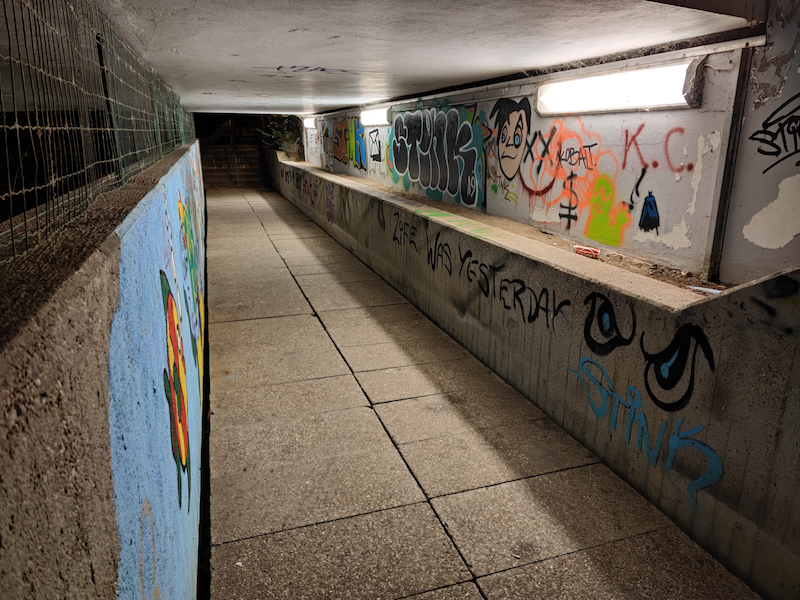The Xiaomi Mi 11 Review: A Gorgeous Screen and Design
by Andrei Frumusanu on March 10, 2021 8:00 AM EST- Posted in
- Mobile
- Smartphones
- Xiaomi
- Snapdragon 888
- Mi 11
Camera - Low Light Evaluation
Low-light photography of the Mi 11 on paper shouldn’t be exactly a strong-point of the device: Due to the way the main sensor is 2x2 binning to 27MP at the lowest resolution, it means that it effectively has smaller pixels than comparable 12MP shooters, or even the other 1/1.3”-class sensors from Samsung or even Huawei. On top of this, the Mi 11 has a smaller aperture versus the Mi 10 Pro in the optics. Still, the new phone has a newer SoC so maybe there’s some new processing algorithms which could come to play in terms of generationally improving the low-light capabilities of the phone.

[ Mi 11 - ] [ Mi 10 Pro - ]
[ S21U(S) - ] [ S21U(E) - ]
[ S21(E) - ] [ S20+(E) - ]
[ Note20U(S) - ] [ iPhone 12 Pro - ]
[ Mate40 Pro - ] [ Pixel 5 - ]
[ X-T30 ( ) ]
In the first scene here, we see a very different result when looking at the Mi 11 compared to the Mi 10 Pro, and it’s actually not a positive one. The Mi 11 regresses in terms of dynamic range, posting brighter highlights (than they should be) and darker shadows with less detail. The EXIF says the Mi 11 had a twice as long exposure – though the loss of detail in the shadows points out that the night mode processing is very different.
Although the Mi 11 has strong natural detail retention, the competition just does better in terms of bringing out details in the darkness.
The ultra-wide’s night mode hardly makes any difference on the Mi 11 which is a bit weird, as the Mi 10’s was quite adequate.

[ Mi 11 - ] [ Mi 10 Pro - ]
[ S21U(S) - ] [ S21U(E) - ]
[ S21(E) - ] [ S20+(E) - ]
[ Note20U(S) - ] [ iPhone 12 Pro - ]
[ Mate40 Pro - ] [ Pixel 5 - ]
[ X-T30 ( ) ]
In terms of colour temperature, the Mi 11 was quite off in terms of the magenta hue. Where’s still reasonable amount of even light, the Mi 11 again does really well with details due its higher resolution sensor.

[ Mi 11 - ] [ Mi 10 Pro - ]
[ S21U(S) - ] [ S21U(E) - ]
[ S21(E) - ] [ S20+(E) - ]
[ Note20U(S) - ] [ iPhone 12 Pro - ]
[ Mate40 Pro - ] [ Pixel 5 - ]
[ X-T30 ( ) ]
Here, although the Mi 11 overdid it in terms of the colour temperature compensation and really isn’t representative of the hue of the sodium vapour lamps, the Mi 11 still somehow manages a very good compositions in the tone curves.

[ Mi 11 - ] [ Mi 10 Pro - ]
[ S21U(S) - ] [ S21U(E) - ]
[ S21(E) - ] [ S20+(E) - ]
[ Note20U(S) - ] [ iPhone 12 Pro - ]
[ Mate40 Pro - ] [ Pixel 5 - ]
[ X-T30 ( ) ]
In terms of raw dynamic range in night mode, the Mi 11 doesn’t fare as well as some of the competition, however it’s still above average, and it does a much better tone-mapping than the Mi 10, maintaining better mid-tone contrast whereas the predecessor tended to make things very flat.

[ Mi 11 ] [ Mi 10 Pro ]
[ S21U(S) ] [ S21U(E) ]
[ S21(E) ] [ S20+(E) ]
[ Note20U(S) ] [ iPhone 12 Pro ]
[ Mate40 Pro - ] [ Pixel 5 ]
[ X-T30 ( ) ]
In even more low-light conditions, the Mi 11 does very well in the overall scene. The phone prefers to bring out shadows rather than maintaining highlight details, but that’s generally acceptable for the end-result.
Unfortunately the ultra-wide isn’t really usable here, the Samsung phones and their superior sensor as well as Huawei are well ahead in terms of quality.

[ Mi 11 ] [ Mi 10 Pro ]
[ S21U(S) ] [ S21U(E) ][ S21(E) ] [ S20+(E) ] [ Note20U(S) ]
[ iPhone 12 Pro ] [ Mate40 Pro - ] [ Pixel 5 ]
[ X-T30 ( ) ]
Finally, a scene that I did just for fun was the night sky when in handheld mode. It’s not really a realistic shooting mode, but it does show some of the processing styles of the phones. The Mi 11 has better noise control than the Mi 10 but due to the exposure being twice as long we’re seeing obvious ghosting and mirror images in the stars – either that, or the image stacking algorithm from Xiaomi isn’t quite as strong as the competition.
Low-light verdict: Not the best, but still quite good
The general conclusion for low-light capabilities of the Mi 11 is that it’s a plenty adequate shooter with some strengths as well as some weaknesses. Xiaomi’s processing isn’t quite as strong as Samsung’s, but does better than other vendors bar Huawei. The capabilities of the sensor are still plenty, and in general it’s a competent shooter. On the ultra-wide module however, the sensor really is far too weak, and even night mode cannot save it, producing images that are far too dark and barely usable compared to other high-end competitors.










85 Comments
View All Comments
Pedro10alves - Thursday, March 11, 2021 - link
Nice to see you in my home country Luxembourg. Wonderful picturesSpellingBee889 - Thursday, March 11, 2021 - link
Our world is youMoePtyan - Friday, March 26, 2021 - link
Thank you Andrei Frumusanu for the review.I am a reader from China and of course a digital fan. I would like to add some explanations to some of the article based on what I have learned.
The SoC power control strategy is different for real games and benchmark tests. It's because Xiaomi added the " God hidden mode" as a means of global background control of running power in earlier versions of MIUI. The principle of its implementation is to define the SoC temperature threshold and SoC frequency for different Apps, and even control the hardware refresh rate of the screen when different Apps are opened.
The configuration file of "God Hidden Mode" is sent from the cloud, and the update frequency is 7-15 days as long as the phone is connected to the Internet. You can call *#*#76937#*#* to check the control panel of this profile.The difference between "China server" and "International server" is the configuration for different regions of Apps. I have a positive opinion about the " God Hidden Mode". You can call *#*#76937#*#* to check the control panel of this profile.The difference between "China server" and "International server" is the configuration for different regions of Apps.
I have a positive opinion about the " God hidden mode " approach, and I am a Genshin Impact player.Due to the presence of the "hidden mode", the X1 big core often runs below 1Ghz while gaming, which results in better sustained performance and temperature threshold performance. Of course, this feature is definitely not meant for benchmarking fraud, but for better longevity and sustained performance.
MoePtyan - Friday, March 26, 2021 - link
Incidentally, this profile can be deleted. In the application management of the settings panel, find "Power & Performance" (I'm not sure if this is the name of the international version of MIUI) and clear the application data, and the temperature and frequency profiles of all Apps will be deleted. At this point the phone is not suitable for daily use, the battery life is very bad, often hot, but the performance has been unlocked. Many senior Chinese players will use this method, the phone plus the cooling back clip together.Samrich - Tuesday, June 1, 2021 - link
1